AMD Radeon VII: High-End Dash (Part 3)
Part 1 >> Part 2 >> Part 3
Perhaps enough about games. Consider the computational aspects of the Radeon VII. Although it is basically similar to the first-generation Vega, there is a lot of noise around it about the improved computing power of the Vega 20. It’s time for us to sort out this issue.

Beginning with CompuBench 2.0, Kishonti's latest GPU computing test iteration offers a wide range of computational workloads, and we decided to focus on level set segmentation (LSM), optical flow modeling, and N-body simulation.
')
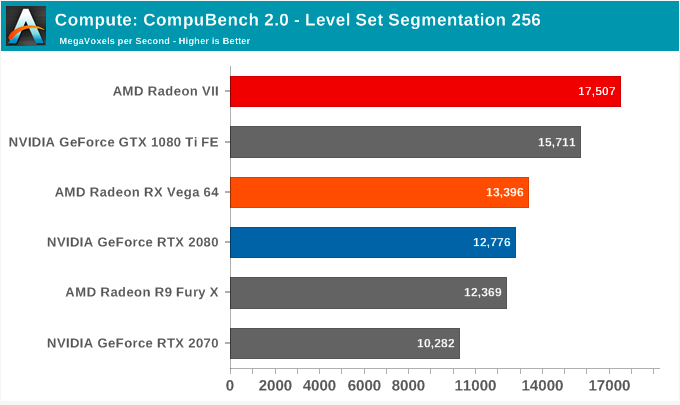

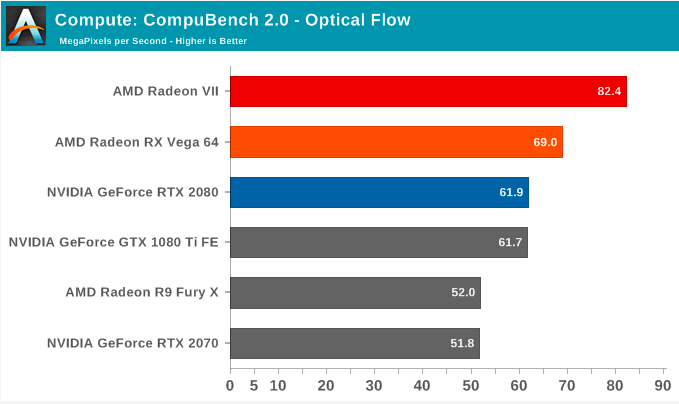
Next, we look at single-precision floating point performance using FAHBench, the official benchmark of Folding @ Home. Folding @ Home is a popular research and distributed computing initiative supported by Stanford, which is distributed to millions of volunteer computers via the Internet, and each computer is responsible for a tiny piece of protein folding simulation. FAHBench can test single and double precision floating point performance, with single precision being the most important indicator for most consumer cards due to poor double precision performance.
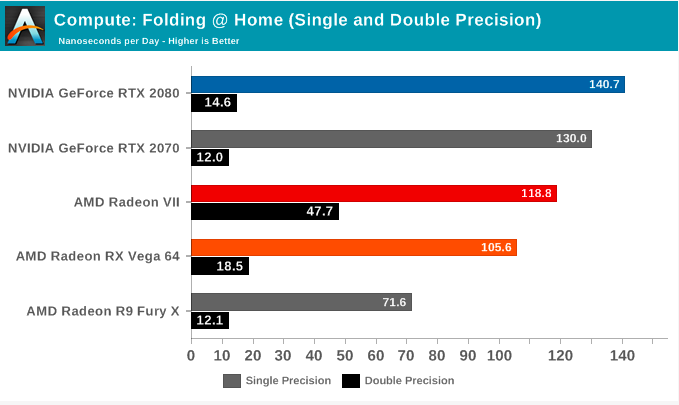
Next comes the GPU computing package using Geekbench 4. This is a multi-faceted test suite that runs seven different GPU sub-tests — from face detection to fast Fourier transform, and then their estimates are averaged over their geometric mean. As a result, Geekbench 4 does not test any single workload, but is an average of many different basic loads.
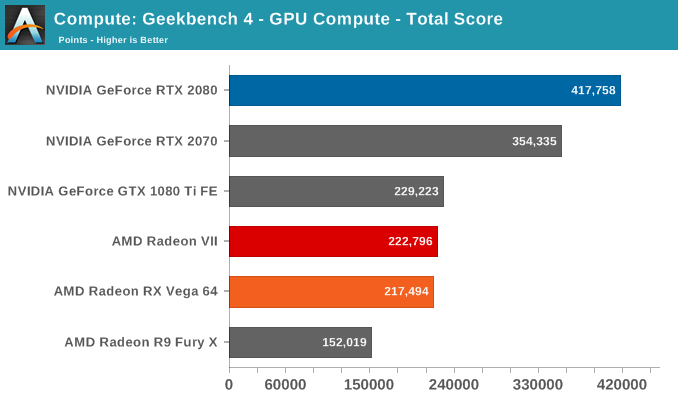
Finally, we have SiSoftware Sandra, with general computational tests with different accuracy.
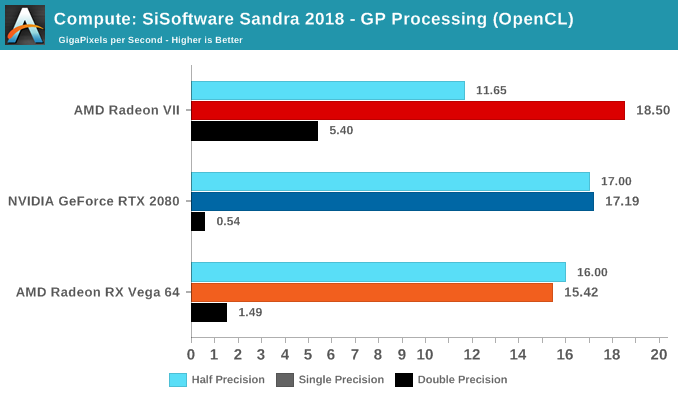
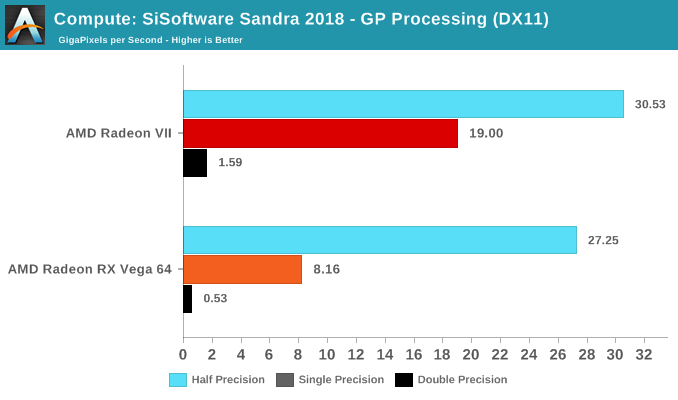

Below are the results of our synthetic tests.
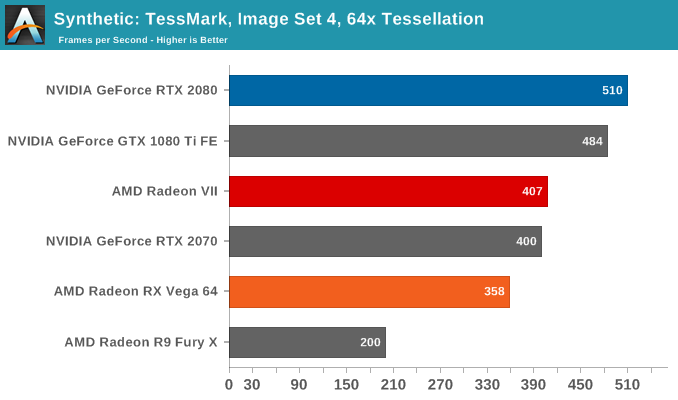


Since AMD is actively promoting the Radeon VII as a semi-professional card for content creation, we should pay attention to rendering performance, CAD and professional visualization. Nevertheless, suitable accurate benchmarks for this area are not so easy to find, especially since productivity depends heavily on the workflow and proprietary licensed ISV software. Given the AnandTech audience, which often includes engineers using these applications in mission-critical production environments, our goal is to provide the most relevant metrics. However, as Ian discussed earlier, the most accurate benchmarking tests for workstations for professional applications are in the hands of independent software vendors. And these suppliers are at best unhappy, and often they don’t want to hear about providing access to software, even in the form of limited licenses.
Given these challenges, the next best thing to evaluate the overall performance of a desktop GPU is the venerable SPECviewperf, recently updated to version 13. Divided into “viewsets”, which are groups of workloads for specific applications derived from real data sets, SPECviewperf has long been a package tests overall performance of desktop / cad gpu. For SPECviewperf 13, test suites are based on:
Although we did not have time to fully test video editing / production software such as Adobe Premiere Pro CC, we will try to add this in the future.
The results obtained make it clear that some test suites work better on equipment from one manufacturer than on another. Sometimes the Radeon VII breaks the trend, although in Siemens NX, reduced performance may be due to driver immaturity. In reverse scenarios, such as Creo-02 or Maya-05, the Radeon VII changes places with competitors, naturally ahead of the RX Vega 64, but behind the RTX and GTX cards. And although the results underline the importance of software availability for new hardware, we see signs that Vega 20 is a powerful board for workstations. The disadvantage is that the new one does not change the overall picture for applications that traditionally work well on NVIDIA hardware.
The following test suite evaluates rendering performance. Given the nature of the "rendering wars", as well as the features of CUDA, it is necessary to clarify that the rendering engines presented do not necessarily show the overall rendering capabilities of the GPU. Since we are looking at the Radeon VII, it is not practical to use some of the most popular visualization tools, such as Redshift and Octane, which are intended only for CUDA, on the other hand, the use of the not very popular Indigo Renderer provides another data point.

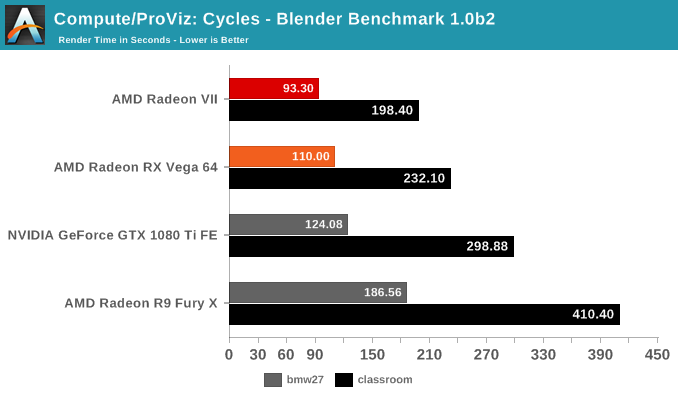
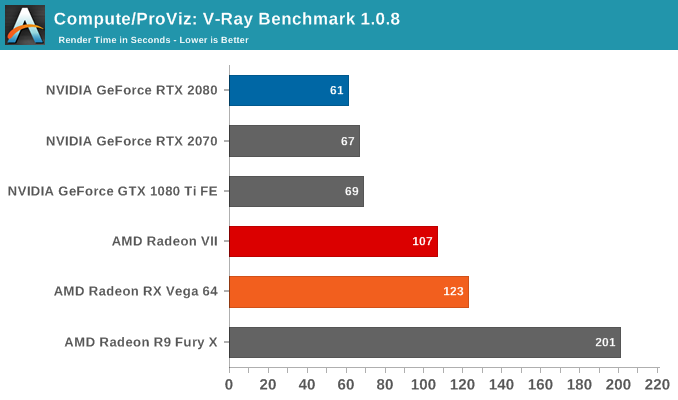
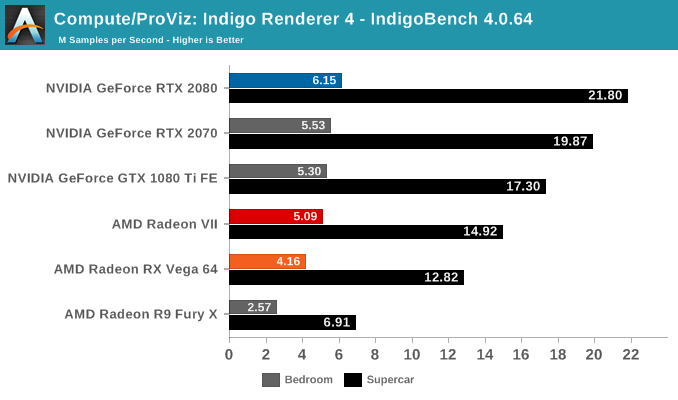
Note that the official Blender editions still do not include CUDA 10, so the RTX 20 series cards are not officially supported.
V-RAY is the only test that uses CUDA for NVIDIA cards, while the rest use OpenCL. The results are generally similar to the SPECviewperf, where the Radeon VII continues to be a leader where AMD hardware used to work well before.
Thanks to the various changes that occurred on the way from the RX Vega 64 based on the Vega 10 to the new Radeon VII based on the Vega 20, we wanted to take a look at the performance and computational capabilities while controlling their clock frequency. This will allow us to look at any significant improvements or differences in the pseudo-IPC. There are a couple of refinements here; Obviously, since the RX Vega 64 has 64 CU and the Radeon VII is only 60 CU, the comparison is no longer accurate. Another thing is that “IPC” is not an accurate measurable indicator, but in a sense, how much graphical / computational work is performed per clock cycle, and how this may affect performance. Isoclock GPU comparisons are usually not very useful when comparing generations and architectures. For example, Vega developers often design pipeline stages to provide higher clock speeds, but at the expense of reducing the amount of work performed per cycle, and, as a rule, increasing the delay.
In our case, the incremental nature of the second generation Vega eliminates some of the problems listed, although, unfortunately, Wattman currently could not lower the memory frequency, so we could not get data for the case when both cards are tuned to comparable memory bandwidth. Although the mechanics of improving the performance of the GPU Vega means that the clock frequency is not fixed, both cards were tuned to a frequency of 1500 MHz, and in both cases the frequency ranged from 1490 to 1500 MHz, depending on the workload. All this means that the results should be understood as approximate, and yet they are useful for determining a significant increase or decrease. This also means that it is very difficult to interpret the results, but at a high level of abstraction, if the Radeon VII exceeds the RX Vega 64 at a given load not related to memory, we can assume significant improvements in “work per cycle” that are not related to the number of CUs.
As usual, it's time to consider the power consumption, temperature and noise of the Radeon VII. Although we usually rely on voltage and clock frequency, taking into account changes in the SMU, such an approach is impossible for the first time.
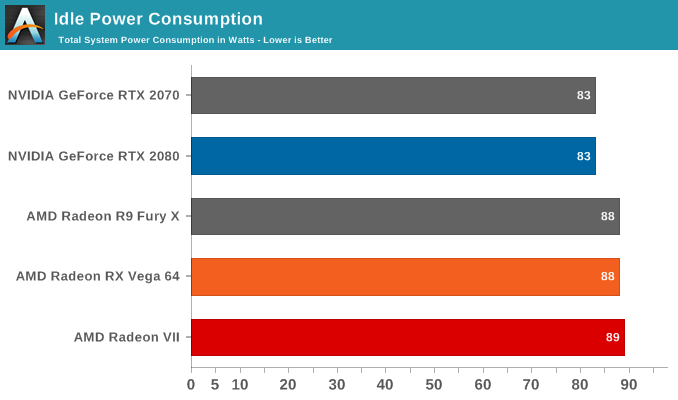
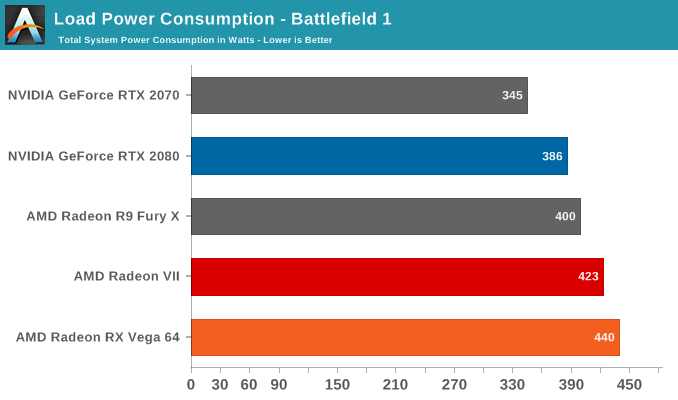

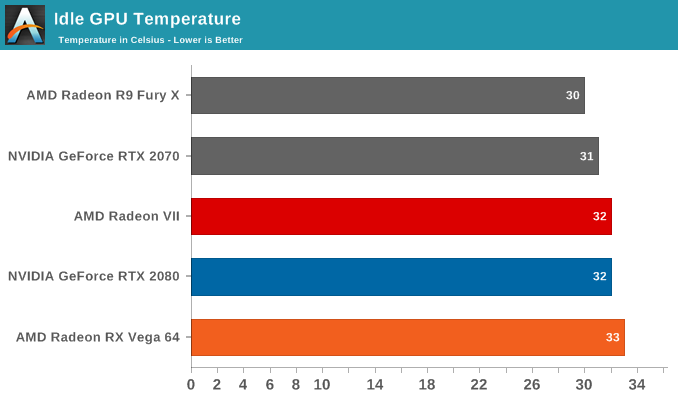
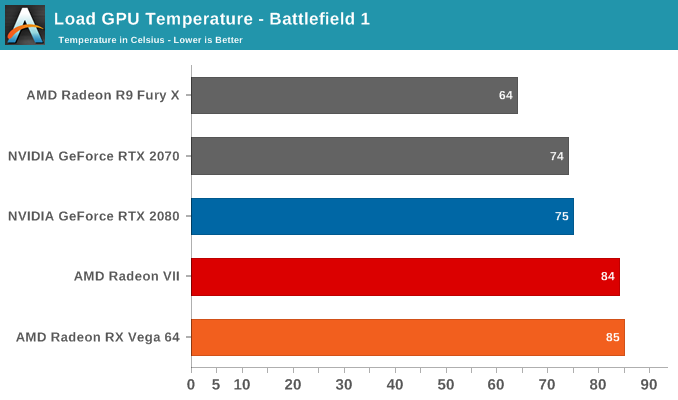
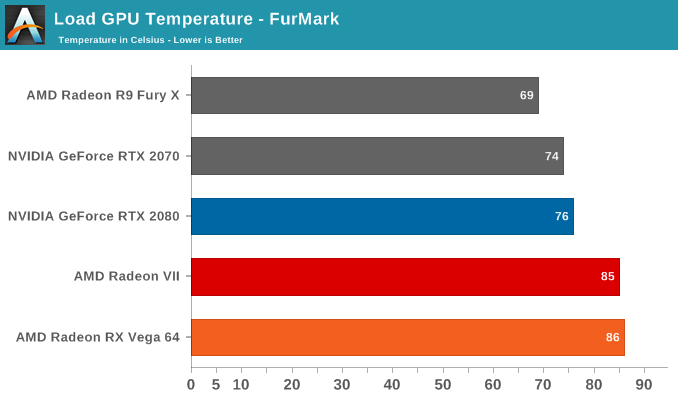
At first glance, the noise level of the card looks surprisingly low. Ultimately, what we see here is a consequence of the application of all possible acoustic enhancements to the card with an open triple fan. Switching to a new type makes the noise of the card comparable to the RX Vega 64 air duct.
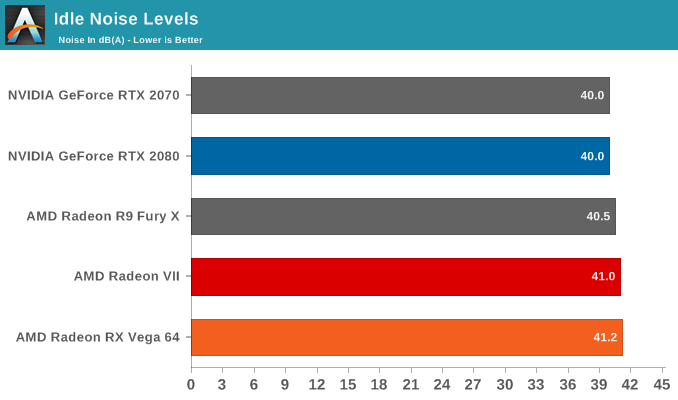
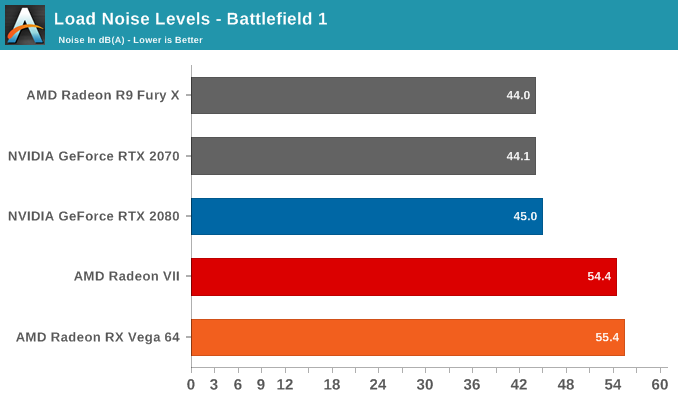
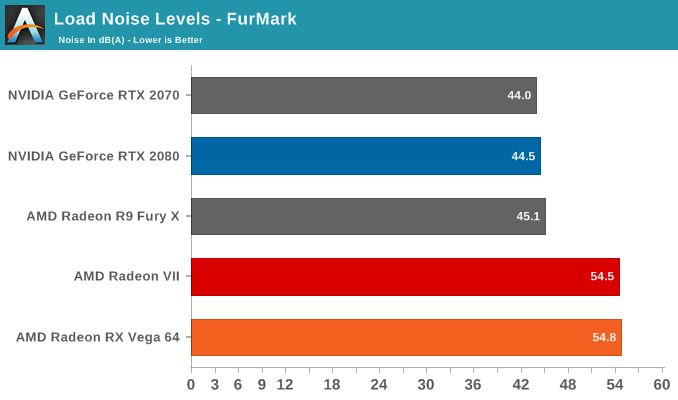
Although there are still many areas to explore, the Radeon VII is still the first 7nm gaming GPU, and this is no small achievement. But besides this, bringing it to the consumer market gives buyers the opportunity to choose among producers; and the more choices for enthusiasts, the better. Radeon VII may look like a dual-purpose product - for professional and gaming applications, but it still remains the fastest gaming graphics card on the Radeon stack.
At the risk of being annoying, I still can’t help but stress how surprised both Ryan and I are that this card came out so early. Currently, the 7nm technology is only taking the first steps, and until last month, AMD seemed to be pleased with the use of the Vega 20 GPU on the Radeon Instinct server cards. And then there was an unexpected confluence of factors that allowed AMD to introduce the chip, which, by their own admission, was originally created for servers, as the flagship in the consumer market. This may be a very good precedent for the launch of the Radeon VII, but it makes the situation quite interesting for technical enthusiasts.
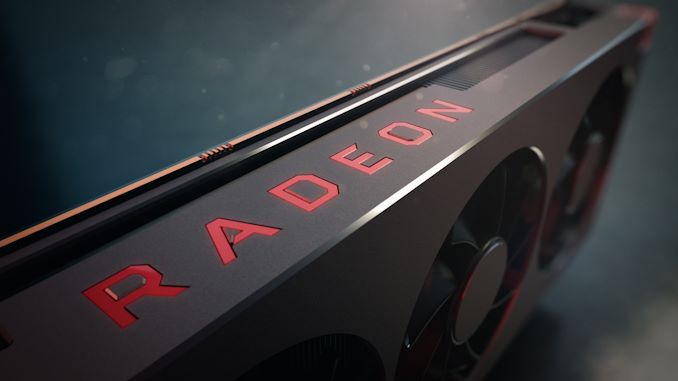
Summing up, let's talk about performance indicators. From its main competitor, the GeForce RTX 2080, the Radeon VII is 5-6% behind in our test suite. Unfortunately, the only games in which he showed the best results are Far Cry 5 and Battlefield 1, so the Radeon VII could not “exchange blows” with a competitor as much as AMD would like to see. At the same time, unlike the RTX 2080, AMD does not want to shake the price-performance ratio, so the Radeon VII in no way interrupts the prices for the 2080. This is quite a reasonable choice for AMD, given the current market situation. But it also means that when the card does not work fast enough, there is no cost advantage to cover the performance lag.
As for performance compared to the original RX Vega 64, the Radeon VII looks even better than we thought. According to the latest data, the new flagship Radeon is 24% faster at 1440p, and 32% faster at 4K resolution than its predecessor. Thus, despite the interesting configuration of the core, in which the Radeon VII comes with a smaller amount of CU than the RX Vega 64, the Radeon VII is well ahead of its predecessor.
In general, AMD launched the product, faced with a difficult struggle, both in terms of technology and product positioning. And the results for AMD are mixed. Although in modern games it is extremely difficult to benefit from 16 GB of video memory, I'm not ready to write it off as an unimportant factor. In the past two and a half years, the possibilities of VRAM video cards have not changed much, perhaps the time has come. However, at the moment AMD's additional VRAM will bring little useful information to gamers.
Content creation, on the other hand, looks much more interesting. Unlike games, there is no standard workload, so I can only speak in general phrases. Radeon VII is a fast card with 16 GB of video memory; This card, which has no analogues in the market. And if semi-professional or professional visualization users who want to work with minimal investment have a workload that really requires more than 8–11 gigabytes of video memory, then Radeon VII should be paid attention to. It would not be superfluous to recall the benefits of professional support, AMD professional drivers and other services that AMD will undoubtedly present to professional users of the Radeon Pro-Grade Vega 20 card.
As for AMD's technological victories, it is important to note that the Radeon VII showed a significant improvement in Vega. The disadvantage of AMD is that the Radeon VII is still Vega. I don’t want to talk much about ray tracing or other gaming moments, because I’m not sure that we can add anything significant to our GeForce reviews. But overall, the Vega 20 is a host of small, neat additions to the Vega architecture, even if they are not intended for consumers.
What worries me most is that AMD’s strategy for configuring its cards has not changed much as compared to the RX Vega 64: AMD is still chasing performance above the rest. This makes sense, given the position of AMD, but it also means that the Radeon VII is not even trying to eliminate some of the shortcomings of its predecessor, which is especially noticeable from the competition. The Radeon VII has many advantages, but energy efficiency is not one of them.
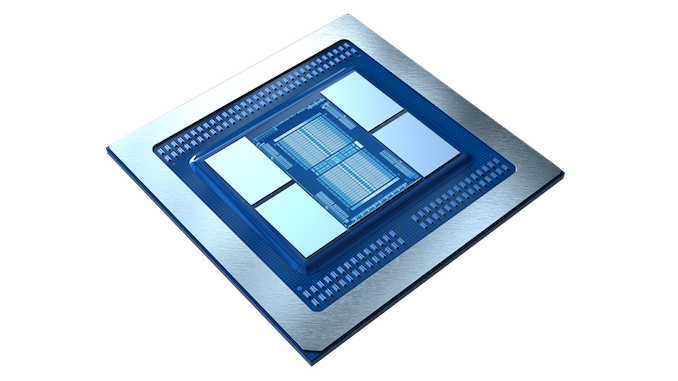
In general, Radeon VII is doing everything possible to offer itself as a semi-professional card with a high volume of VRAM for game content creators. And at a price of $ 699, this is a good niche in the market. However, for pure gamers it is more difficult to sell this card instead of the more productive GeForce RTX 2080 from NVIDIA.
So where did AMD end up? Fortunately for the Radeon rebels, their situation is still improving, even if the overall competitive environment has not changed significantly. This is not a victory for AMD, but an opportunity to compete with NVIDIA at a new level. AMD is still competitive. They can compete in performance, and thanks to Vega 20 they have a lot of new computing functions. The new product will advance the AMD business today, and it will help AMD prepare for tomorrow and the next stage - Navi. This is still a tough battle, but with the Radeon VII and Vega 20, AMD took another step up.
Thank you for staying with us. Do you like our articles? Want to see more interesting materials? Support us by placing an order or recommending to friends, 30% discount for Habr's users on a unique analogue of the entry-level servers that we invented for you: The whole truth about VPS (KVM) E5-2650 v4 (6 Cores) 10GB DDR4 240GB SSD 1Gbps from $ 20 or how to share the server? (Options are available with RAID1 and RAID10, up to 24 cores and up to 40GB DDR4).
VPS (KVM) E5-2650 v4 (6 Cores) 10GB DDR4 240GB SSD 1Gbps before summer for free if you pay for a period of six months, you can order here .
Dell R730xd 2 times cheaper? Only we have 2 x Intel Dodeca-Core Xeon E5-2650v4 128GB DDR4 6x480GB SSD 1Gbps 100 TV from $ 249 in the Netherlands and the USA! Read about How to build an infrastructure building. class c using servers Dell R730xd E5-2650 v4 worth 9000 euros for a penny?
Computing Performance
Perhaps enough about games. Consider the computational aspects of the Radeon VII. Although it is basically similar to the first-generation Vega, there is a lot of noise around it about the improved computing power of the Vega 20. It’s time for us to sort out this issue.

Beginning with CompuBench 2.0, Kishonti's latest GPU computing test iteration offers a wide range of computational workloads, and we decided to focus on level set segmentation (LSM), optical flow modeling, and N-body simulation.
')



Next, we look at single-precision floating point performance using FAHBench, the official benchmark of Folding @ Home. Folding @ Home is a popular research and distributed computing initiative supported by Stanford, which is distributed to millions of volunteer computers via the Internet, and each computer is responsible for a tiny piece of protein folding simulation. FAHBench can test single and double precision floating point performance, with single precision being the most important indicator for most consumer cards due to poor double precision performance.

Next comes the GPU computing package using Geekbench 4. This is a multi-faceted test suite that runs seven different GPU sub-tests — from face detection to fast Fourier transform, and then their estimates are averaged over their geometric mean. As a result, Geekbench 4 does not test any single workload, but is an average of many different basic loads.

Finally, we have SiSoftware Sandra, with general computational tests with different accuracy.



Synthetic performance
Below are the results of our synthetic tests.



Professional visualization and rendering
Since AMD is actively promoting the Radeon VII as a semi-professional card for content creation, we should pay attention to rendering performance, CAD and professional visualization. Nevertheless, suitable accurate benchmarks for this area are not so easy to find, especially since productivity depends heavily on the workflow and proprietary licensed ISV software. Given the AnandTech audience, which often includes engineers using these applications in mission-critical production environments, our goal is to provide the most relevant metrics. However, as Ian discussed earlier, the most accurate benchmarking tests for workstations for professional applications are in the hands of independent software vendors. And these suppliers are at best unhappy, and often they don’t want to hear about providing access to software, even in the form of limited licenses.
Given these challenges, the next best thing to evaluate the overall performance of a desktop GPU is the venerable SPECviewperf, recently updated to version 13. Divided into “viewsets”, which are groups of workloads for specific applications derived from real data sets, SPECviewperf has long been a package tests overall performance of desktop / cad gpu. For SPECviewperf 13, test suites are based on:
- Autodesk 3ds Max 2016 (Nitrous DX11 driver)
- Dassault Systèmes CATIA V6 R2012
- PTC Creo 3 & Creo 4
- Geosurvey software, workflows based on rendering techniques, utilized by the open-source OpendTect seismic visualization application
- Autodesk Maya 2017
- Radiological (i.e. CT, MRI scans) rendering, with the workloads
- Autodesk Showcase 2013
- Siemens NX 8.0
- Dassault Systèmes Solidworks 2013 SP1
Although we did not have time to fully test video editing / production software such as Adobe Premiere Pro CC, we will try to add this in the future.
Test Plots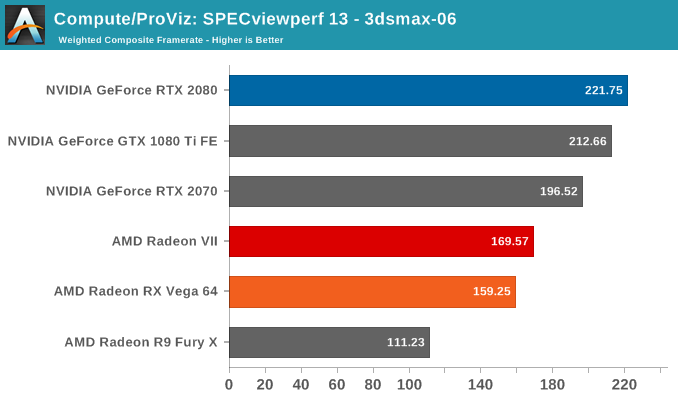

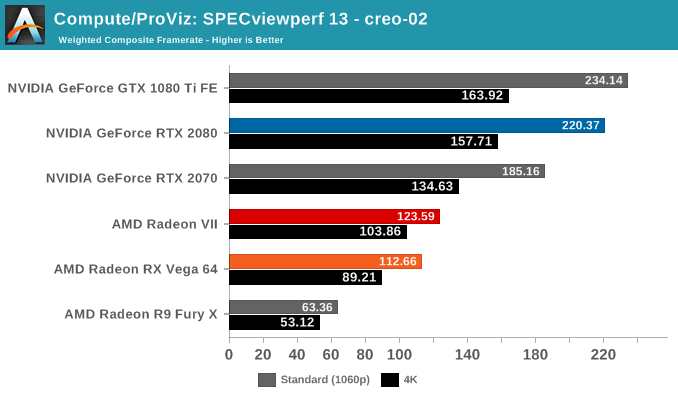
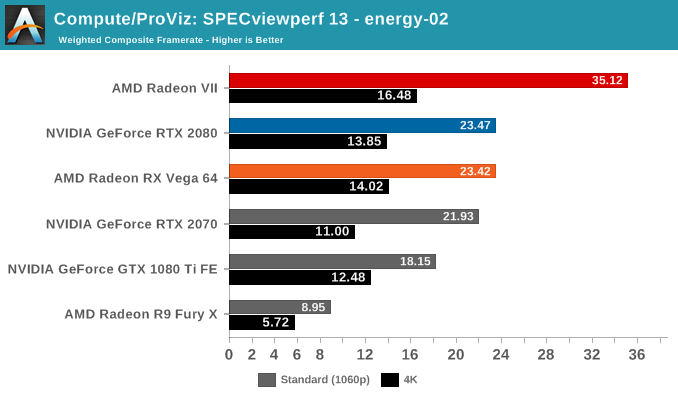
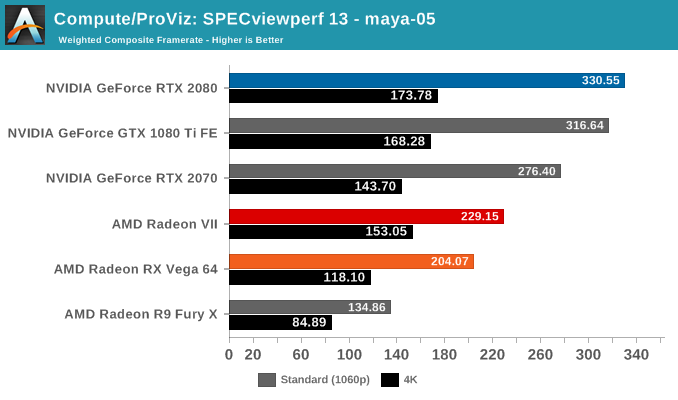
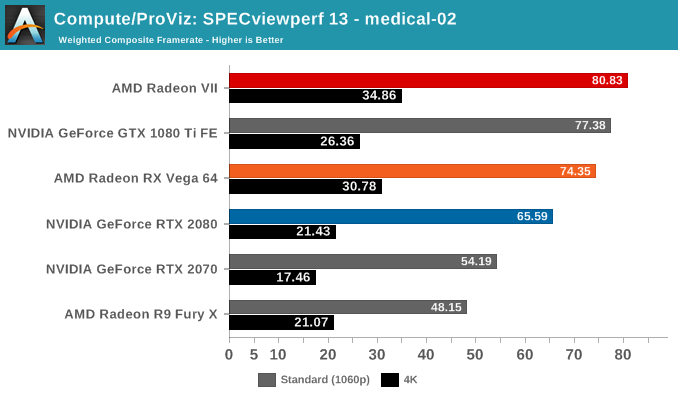

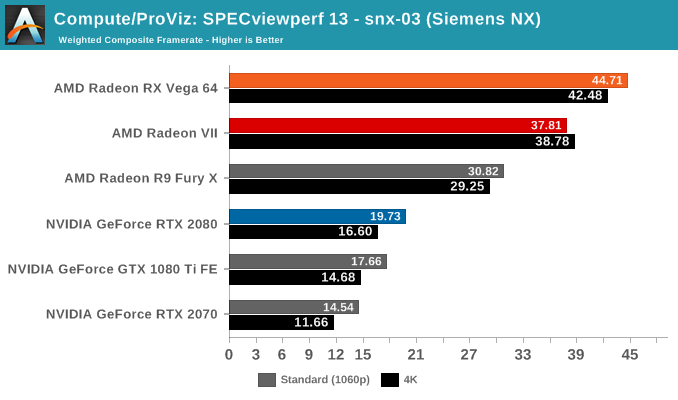
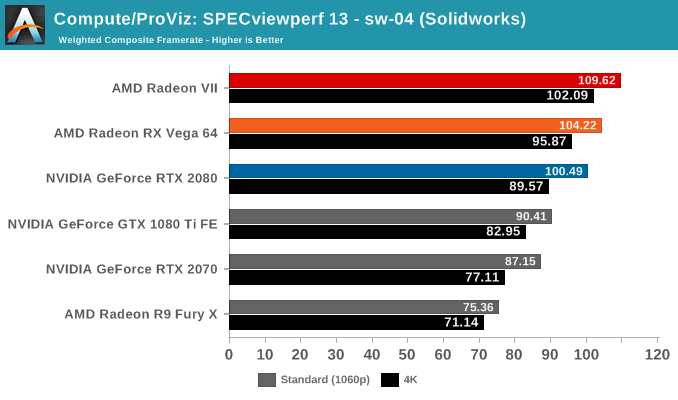









The results obtained make it clear that some test suites work better on equipment from one manufacturer than on another. Sometimes the Radeon VII breaks the trend, although in Siemens NX, reduced performance may be due to driver immaturity. In reverse scenarios, such as Creo-02 or Maya-05, the Radeon VII changes places with competitors, naturally ahead of the RX Vega 64, but behind the RTX and GTX cards. And although the results underline the importance of software availability for new hardware, we see signs that Vega 20 is a powerful board for workstations. The disadvantage is that the new one does not change the overall picture for applications that traditionally work well on NVIDIA hardware.
The following test suite evaluates rendering performance. Given the nature of the "rendering wars", as well as the features of CUDA, it is necessary to clarify that the rendering engines presented do not necessarily show the overall rendering capabilities of the GPU. Since we are looking at the Radeon VII, it is not practical to use some of the most popular visualization tools, such as Redshift and Octane, which are intended only for CUDA, on the other hand, the use of the not very popular Indigo Renderer provides another data point.




Note that the official Blender editions still do not include CUDA 10, so the RTX 20 series cards are not officially supported.
V-RAY is the only test that uses CUDA for NVIDIA cards, while the rest use OpenCL. The results are generally similar to the SPECviewperf, where the Radeon VII continues to be a leader where AMD hardware used to work well before.
Radeon VII and Radeon RX Vega 64: Clock Performance
Thanks to the various changes that occurred on the way from the RX Vega 64 based on the Vega 10 to the new Radeon VII based on the Vega 20, we wanted to take a look at the performance and computational capabilities while controlling their clock frequency. This will allow us to look at any significant improvements or differences in the pseudo-IPC. There are a couple of refinements here; Obviously, since the RX Vega 64 has 64 CU and the Radeon VII is only 60 CU, the comparison is no longer accurate. Another thing is that “IPC” is not an accurate measurable indicator, but in a sense, how much graphical / computational work is performed per clock cycle, and how this may affect performance. Isoclock GPU comparisons are usually not very useful when comparing generations and architectures. For example, Vega developers often design pipeline stages to provide higher clock speeds, but at the expense of reducing the amount of work performed per cycle, and, as a rule, increasing the delay.
In our case, the incremental nature of the second generation Vega eliminates some of the problems listed, although, unfortunately, Wattman currently could not lower the memory frequency, so we could not get data for the case when both cards are tuned to comparable memory bandwidth. Although the mechanics of improving the performance of the GPU Vega means that the clock frequency is not fixed, both cards were tuned to a frequency of 1500 MHz, and in both cases the frequency ranged from 1490 to 1500 MHz, depending on the workload. All this means that the results should be understood as approximate, and yet they are useful for determining a significant increase or decrease. This also means that it is very difficult to interpret the results, but at a high level of abstraction, if the Radeon VII exceeds the RX Vega 64 at a given load not related to memory, we can assume significant improvements in “work per cycle” that are not related to the number of CUs.
Test Plots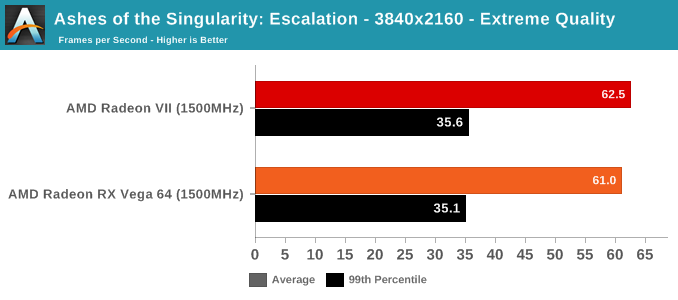
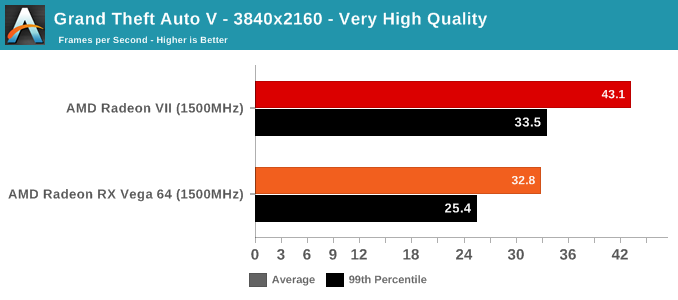
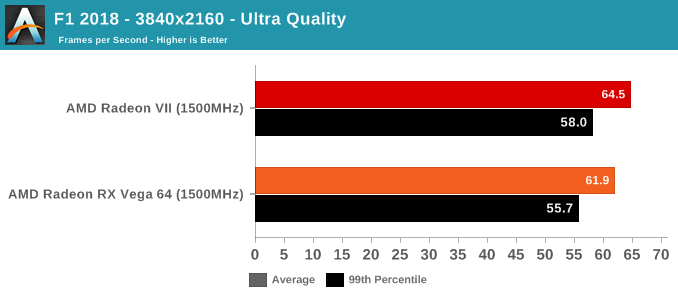

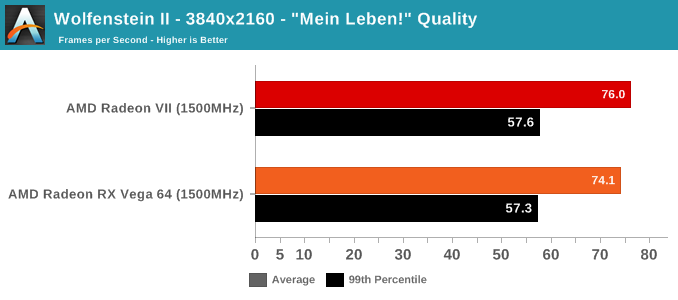

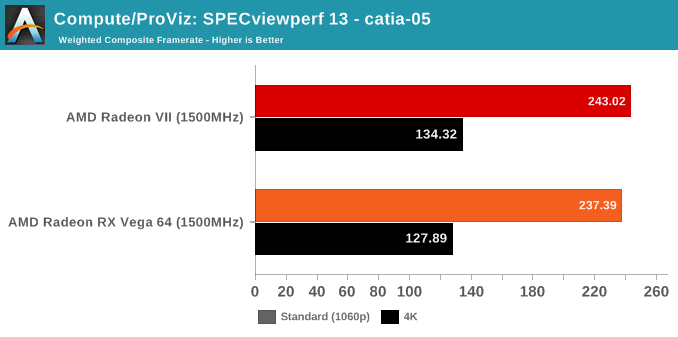

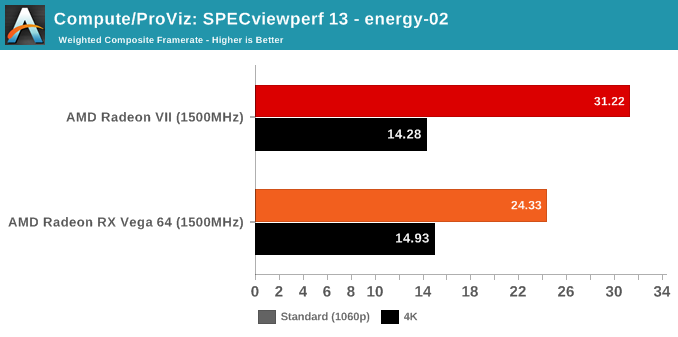
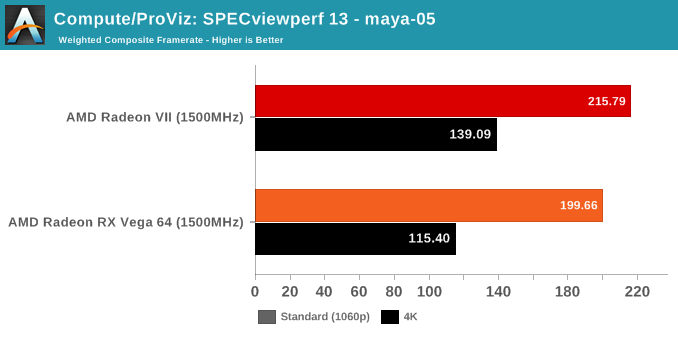
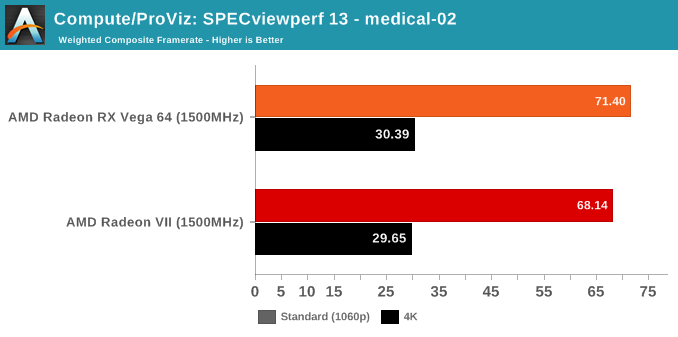

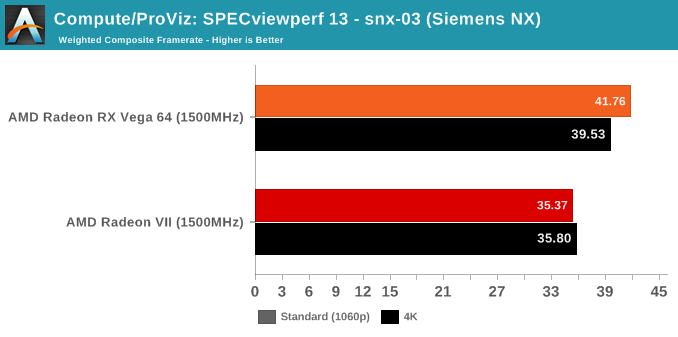
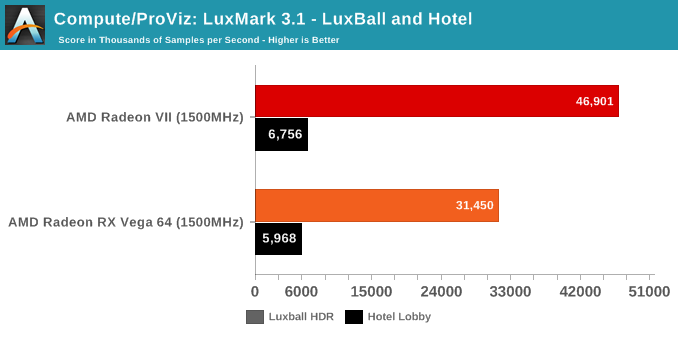

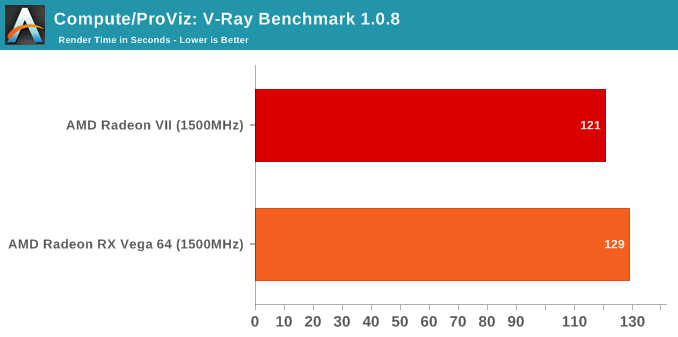
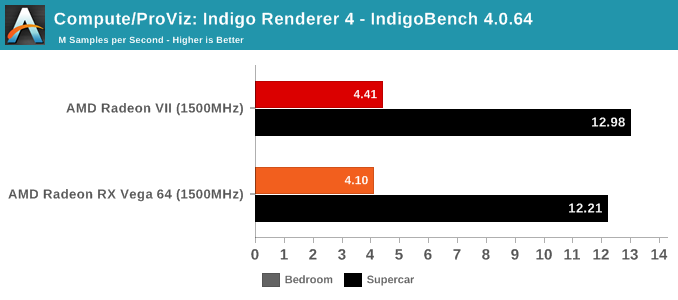

















Consumption, temperature and noise
As usual, it's time to consider the power consumption, temperature and noise of the Radeon VII. Although we usually rely on voltage and clock frequency, taking into account changes in the SMU, such an approach is impossible for the first time.






At first glance, the noise level of the card looks surprisingly low. Ultimately, what we see here is a consequence of the application of all possible acoustic enhancements to the card with an open triple fan. Switching to a new type makes the noise of the card comparable to the RX Vega 64 air duct.



As a conclusion
Although there are still many areas to explore, the Radeon VII is still the first 7nm gaming GPU, and this is no small achievement. But besides this, bringing it to the consumer market gives buyers the opportunity to choose among producers; and the more choices for enthusiasts, the better. Radeon VII may look like a dual-purpose product - for professional and gaming applications, but it still remains the fastest gaming graphics card on the Radeon stack.
At the risk of being annoying, I still can’t help but stress how surprised both Ryan and I are that this card came out so early. Currently, the 7nm technology is only taking the first steps, and until last month, AMD seemed to be pleased with the use of the Vega 20 GPU on the Radeon Instinct server cards. And then there was an unexpected confluence of factors that allowed AMD to introduce the chip, which, by their own admission, was originally created for servers, as the flagship in the consumer market. This may be a very good precedent for the launch of the Radeon VII, but it makes the situation quite interesting for technical enthusiasts.

Summing up, let's talk about performance indicators. From its main competitor, the GeForce RTX 2080, the Radeon VII is 5-6% behind in our test suite. Unfortunately, the only games in which he showed the best results are Far Cry 5 and Battlefield 1, so the Radeon VII could not “exchange blows” with a competitor as much as AMD would like to see. At the same time, unlike the RTX 2080, AMD does not want to shake the price-performance ratio, so the Radeon VII in no way interrupts the prices for the 2080. This is quite a reasonable choice for AMD, given the current market situation. But it also means that when the card does not work fast enough, there is no cost advantage to cover the performance lag.
As for performance compared to the original RX Vega 64, the Radeon VII looks even better than we thought. According to the latest data, the new flagship Radeon is 24% faster at 1440p, and 32% faster at 4K resolution than its predecessor. Thus, despite the interesting configuration of the core, in which the Radeon VII comes with a smaller amount of CU than the RX Vega 64, the Radeon VII is well ahead of its predecessor.
In general, AMD launched the product, faced with a difficult struggle, both in terms of technology and product positioning. And the results for AMD are mixed. Although in modern games it is extremely difficult to benefit from 16 GB of video memory, I'm not ready to write it off as an unimportant factor. In the past two and a half years, the possibilities of VRAM video cards have not changed much, perhaps the time has come. However, at the moment AMD's additional VRAM will bring little useful information to gamers.
Content creation, on the other hand, looks much more interesting. Unlike games, there is no standard workload, so I can only speak in general phrases. Radeon VII is a fast card with 16 GB of video memory; This card, which has no analogues in the market. And if semi-professional or professional visualization users who want to work with minimal investment have a workload that really requires more than 8–11 gigabytes of video memory, then Radeon VII should be paid attention to. It would not be superfluous to recall the benefits of professional support, AMD professional drivers and other services that AMD will undoubtedly present to professional users of the Radeon Pro-Grade Vega 20 card.
As for AMD's technological victories, it is important to note that the Radeon VII showed a significant improvement in Vega. The disadvantage of AMD is that the Radeon VII is still Vega. I don’t want to talk much about ray tracing or other gaming moments, because I’m not sure that we can add anything significant to our GeForce reviews. But overall, the Vega 20 is a host of small, neat additions to the Vega architecture, even if they are not intended for consumers.
What worries me most is that AMD’s strategy for configuring its cards has not changed much as compared to the RX Vega 64: AMD is still chasing performance above the rest. This makes sense, given the position of AMD, but it also means that the Radeon VII is not even trying to eliminate some of the shortcomings of its predecessor, which is especially noticeable from the competition. The Radeon VII has many advantages, but energy efficiency is not one of them.

In general, Radeon VII is doing everything possible to offer itself as a semi-professional card with a high volume of VRAM for game content creators. And at a price of $ 699, this is a good niche in the market. However, for pure gamers it is more difficult to sell this card instead of the more productive GeForce RTX 2080 from NVIDIA.
So where did AMD end up? Fortunately for the Radeon rebels, their situation is still improving, even if the overall competitive environment has not changed significantly. This is not a victory for AMD, but an opportunity to compete with NVIDIA at a new level. AMD is still competitive. They can compete in performance, and thanks to Vega 20 they have a lot of new computing functions. The new product will advance the AMD business today, and it will help AMD prepare for tomorrow and the next stage - Navi. This is still a tough battle, but with the Radeon VII and Vega 20, AMD took another step up.
Thank you for staying with us. Do you like our articles? Want to see more interesting materials? Support us by placing an order or recommending to friends, 30% discount for Habr's users on a unique analogue of the entry-level servers that we invented for you: The whole truth about VPS (KVM) E5-2650 v4 (6 Cores) 10GB DDR4 240GB SSD 1Gbps from $ 20 or how to share the server? (Options are available with RAID1 and RAID10, up to 24 cores and up to 40GB DDR4).
VPS (KVM) E5-2650 v4 (6 Cores) 10GB DDR4 240GB SSD 1Gbps before summer for free if you pay for a period of six months, you can order here .
Dell R730xd 2 times cheaper? Only we have 2 x Intel Dodeca-Core Xeon E5-2650v4 128GB DDR4 6x480GB SSD 1Gbps 100 TV from $ 249 in the Netherlands and the USA! Read about How to build an infrastructure building. class c using servers Dell R730xd E5-2650 v4 worth 9000 euros for a penny?
Source: https://habr.com/ru/post/445220/
All Articles